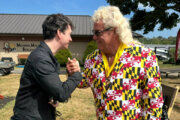In the midst of rising cancellations, crowded grocery stores and concern over catching the new coronavirus, it came as a relief when the first three patients in Montgomery County, Maryland, fully recovered last week and were out of isolation.
Once the coronavirus enters the respiratory system, how does the human body defeat the virus?
First, infection comes through close contact with someone infected by the virus, through respiratory droplets. Or, an individual might touch an environmental surface where the virus dwells, giving the virus entry by touching the face and creating a path for the virus into the respiratory system through the nose or mouth.
“The virus — the one thing that it’s effective at accomplishing is making more of itself. It’s just a replicating machine once it gets inside,” said Dr. Ray Viscidi, a virologist and professor of pediatrics and oncology at Johns Hopkins University School of Medicine.
The invading coronavirus attaches to cells lining the upper airways and infects cells in the tubes, leading to the lungs and moving deeper into the cells lining the lungs, according to Doctor Visicidi, whose research focuses on papillomavirus and polyomaviruses, as well as an interest in coronaviruses.
“The body has two major ways of attacking viruses,” said Dr. Viscidi, “the first response, or the rapid-response, is a type of immunity that is almost ready to go. We’re talking within hours, this type of immunity gets activated or turned on,” he said.
In most cases, the rapid immune system response is not enough to fend off the virus. So, over the course of illness — days, a week or more, the body mounts its second immune response — a dual attack by antibody proteins and cells specifically targeting the invasive virus.
The antibodies bind to the virus and eliminate it. The body manufactures cells to specifically attack only the cells harboring the virus.
“They’re generally called T-cells, and those T-cells will destroy virally-infected cells,” said Dr. Viscidi.
“So you have two mechanisms that are attacking the virus — if the virus particles are floating around, they’re bound by the antibody; if the virus is trying to infect a cell, there are these T-cells that will destroy the infected cells,” he said.
“That whole process evolves over a period of a week or two or three, and ultimately that’s what finally does the job,” Viscidi said.
Treatment during the course of the illness is usually only to support bodily functions and control damage, while giving the body time to expel the coronavirus.








